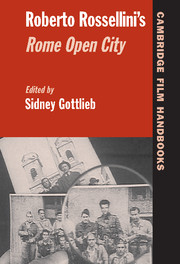Book contents
- Frontmatter
- Contents
- Acknowledgments
- List of Contributors
- Introduction: Open City: Reappropriating the Old, Making the New
- 1 Rossellini, Open City, and Neorealism
- 2 The Making of Roma città aperta: The Legacy of Fascism and the Birth of Neorealism
- 3 Celluloide and the Palimpsest of Cinematic Memory: Carlo Lizzani's Film of the Story Behind Open City
- 4 Diverting Clichés: Femininity, Masculinity, Melodrama, and Neorealism in Open City
- 5 Space, Rhetoric, and the Divided City in Roma città aperta
- 6 Mourning, Melancholia, and the Popular Front: Roberto Rossellini's Beautiful Revolution
- REVIEWS OF OPEN CITY
- Filmography
- Select Bibliography
- Index
3 - Celluloide and the Palimpsest of Cinematic Memory: Carlo Lizzani's Film of the Story Behind Open City
Published online by Cambridge University Press: 09 February 2010
- Frontmatter
- Contents
- Acknowledgments
- List of Contributors
- Introduction: Open City: Reappropriating the Old, Making the New
- 1 Rossellini, Open City, and Neorealism
- 2 The Making of Roma città aperta: The Legacy of Fascism and the Birth of Neorealism
- 3 Celluloide and the Palimpsest of Cinematic Memory: Carlo Lizzani's Film of the Story Behind Open City
- 4 Diverting Clichés: Femininity, Masculinity, Melodrama, and Neorealism in Open City
- 5 Space, Rhetoric, and the Divided City in Roma città aperta
- 6 Mourning, Melancholia, and the Popular Front: Roberto Rossellini's Beautiful Revolution
- REVIEWS OF OPEN CITY
- Filmography
- Select Bibliography
- Index
Summary
It is 1945, Rome has recently been liberated, and Roberto Rossellini joins forces with a scriptwriter, Sergio Amidei, to make a film about the courage and suffering of Romans under the recent Nazi occupation. They face every imaginable obstacle to the realization of their project: a war-torn economy, reluctant producers, lack of raw materials (celluloid was especially scarce), and a film industry wedded to the aesthetics of escape (see Fig. 6). Vaudeville stars Anna Magnani and Aldo Fabrizi are persuaded to join the cast, despite the appallingly severe shortage of funds to meet their salary demands. Rossellini hires Federico Fellini, Fabrizi to lower his price. Personal upheavals threaten to derail the production at every turn. Amidei and his girlfriend, Maria Michi (who plays Marina), break up and reconcile any number of times; Magnani's stormy love affair with the young and unreliable Massimo reaches crisis level in mid-shooting; and her son is afflicted with a dire malady. Producers come and go, plagued by inadequate resources or daunted by the novelty of the project. After a sneak preview, a noted distributor is shocked and pronounces the film unmarketable. In one of the many serendipities that mark the birth of Open City, an American soldier named Rod Geiger discovers that Rossellini has tapped into the power supply used to illuminate the G.I. dance hall next door to the studio. When Geiger realizes that he has stumbled onto a movie set, his anger gives way to fascination and he gallantly offers to distribute the finished product in America.
- Type
- Chapter
- Information
- Roberto Rossellini's Rome Open City , pp. 67 - 84Publisher: Cambridge University PressPrint publication year: 2004

